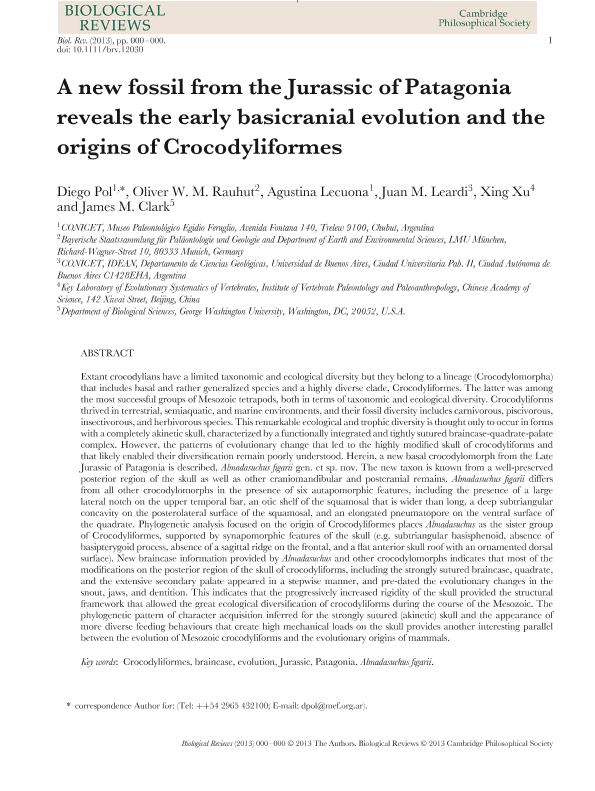Artículo
A new fossil from the Jurassic of Patagonia reveals the early basicranial evolution and the origins of Crocodyliformes
Pol, Diego ; Rauhut, Oliver W. M.; Lecuona, Agustina
; Rauhut, Oliver W. M.; Lecuona, Agustina ; Leardi, Juan Martín
; Leardi, Juan Martín ; Xu, Xing ; Clark, James M.
; Xu, Xing ; Clark, James M.
 ; Rauhut, Oliver W. M.; Lecuona, Agustina
; Rauhut, Oliver W. M.; Lecuona, Agustina ; Leardi, Juan Martín
; Leardi, Juan Martín ; Xu, Xing ; Clark, James M.
; Xu, Xing ; Clark, James M.
Fecha de publicación:
10/2013
Editorial:
Wiley
Revista:
Biological Reviews
ISSN:
1464-7931
Idioma:
Inglés
Tipo de recurso:
Artículo publicado
Clasificación temática:
Resumen
Extant crocodylians have a limited taxonomic and ecological diversity but they belong to a lineage (Crocodylomorpha) that includes basal and rather generalized species and a highly diverse clade, Crocodyliformes. The latter was among the most successful groups of Mesozoic tetrapods, both in terms of taxonomic and ecological diversity. Crocodyliforms thrived in terrestrial, semiaquatic, and marine environments, and their fossil diversity includes carnivorous, piscivorous, insectivorous, and herbivorous species. This remarkable ecological and trophic diversity is thought only to occur in forms with a completely akinetic skull, characterized by a functionally integrated and tightly sutured braincase-quadrate-palate complex. However, the patterns of evolutionary change that led to the highly modified skull of crocodyliforms and that likely enabled their diversification remain poorly understood. Herein, a new basal crocodylomorph from the Late Jurassic of Patagonia is described, Almadasuchus figarii gen. et sp. nov. The new taxon is known from a well-preserved posterior region of the skull as well as other craniomandibular and postcranial remains. Almadasuchus figarii differs from all other crocodylomorphs in the presence of six autapomorphic features, including the presence of a large lateral notch on the upper temporal bar, an otic shelf of the squamosal that is wider than long, a deep subtriangular concavity on the posterolateral surface of the squamosal, and an elongated pneumatopore on the ventral surface of the quadrate. Phylogenetic analysis focused on the origin of Crocodyliformes places Almadasuchus as the sister group of Crocodyliformes, supported by synapomorphic features of the skull (e.g. subtriangular basisphenoid, absence of basipterygoid process, absence of a sagittal ridge on the frontal, and a flat anterior skull roof with an ornamented dorsal surface). New braincase information provided by Almadasuchus and other crocodylomorphs indicates that most of the modifications on the posterior region of the skull of crocodyliforms, including the strongly sutured braincase, quadrate, and the extensive secondary palate appeared in a stepwise manner, and pre-dated the evolutionary changes in the snout, jaws, and dentition. This indicates that the progressively increased rigidity of the skull provided the structural framework that allowed the great ecological diversification of crocodyliforms during the course of the Mesozoic. The phylogenetic pattern of character acquisition inferred for the strongly sutured (akinetic) skull and the appearance of more diverse feeding behaviours that create high mechanical loads on the skull provides another interesting parallel between the evolution of Mesozoic crocodyliforms and the evolutionary origins of mammals.
Palabras clave:
Crocodyliformes
,
Braincase
,
Evolution
,
Jurassic
,
Patagonia
,
Almadasuchus Figarii
Archivos asociados
Licencia
Identificadores
Colecciones
Articulos(CCT-CENPAT)
Articulos de CTRO.CIENTIFICO TECNOL.CONICET - CENPAT
Articulos de CTRO.CIENTIFICO TECNOL.CONICET - CENPAT
Articulos(IDEAN)
Articulos de INSTITUTO DE ESTUDIOS ANDINOS "DON PABLO GROEBER"
Articulos de INSTITUTO DE ESTUDIOS ANDINOS "DON PABLO GROEBER"
Citación
Pol, Diego; Rauhut, Oliver W. M.; Lecuona, Agustina; Leardi, Juan Martín; Xu, Xing ; et al.; A new fossil from the Jurassic of Patagonia reveals the early basicranial evolution and the origins of Crocodyliformes; Wiley; Biological Reviews; 88; 4; 10-2013; 862-872
Compartir
Altmétricas



